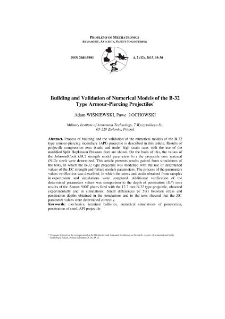Nasza Biblioteka Cyfrowa udostępnia 1 868 obiektów cyfrowych
Obiekt
Tytuł: Building and Validation of Numerical Models of the B-32Type Armour-Piercing Projectiles ; Building and Validation of Numerical Models of the B-32Type Armour-Piercing Projectiles
Współtwórca:
Paweł ŻOCHOWSKI ; Paweł ŻOCHOWSKI
Abstrakt:
Process of building and the validation of the numerical models of the B-32 type armour-piercing incendiary (API) projectile is described in this article. Results of projectile compression tests (static and under high strain rates with the use of the modified Split Hopkinson Pressure Bar) are shown. On the basis of this, the values of the Johnson–Cook (J–C) strength model parameters for the projectile core material (N12e steel) were determined. This article presents results gained from simulations of the tests, in which the B-32 type projectile was modelled with the use of determined values of the J–C strength and failure models parameters. The process of the parameters values verification was described, in which the stress and strain obtained from samples in experiments and simulations were compared. Additional verification of the determined parameters values was comparison to the depth of penetration (DP) tests results of the Armox 500T plates fired with the 12.7 mm B-32 type projectile, obtained experimentally and in simulations. Small differences (< 5%) between stress and penetration depths obtained in the simulations and in the tests showed that the J–C parameter values were determined correctly.
;
Process of building and the validation of the numerical models of the B-32 type armour-piercing incendiary (API) projectile is described in this article. Results of projectile compression tests (static and under high strain rates with the use of the modified Split Hopkinson Pressure Bar) are shown. On the basis of this, the values of the Johnson–Cook (J–C) strength model parameters for the projectile core material (N12e steel) were determined. This article presents results gained from simulations of the tests, in which the B-32 type projectile was modelled with the use of determined values of the J–C strength and failure models parameters. The process of the parameters values verification was described, in which the stress and strain obtained from samples in experiments and simulations were compared. Additional verification of the determined parameters values was comparison to the depth of penetration (DP) tests results of the Armox 500T plates fired with the 12.7 mm B-32 type projectile, obtained experimentally and in simulations. Small differences (< 5%) between stress and penetration depths obtained in the simulations and in the tests showed that the J–C parameter values were determined correctly.
Miejsce wydania:
Warszawa
;
Warszawa
Wydawca:
Wojskowa Akademia Techniczna ; Wojskowa Akademia Techniczna
Data utworzenia:
Data wydania:
Rozmiar:
Identyfikator:
oai:ribes-88.man.poznan.pl:2388
ISSN elektroniczny:
ISSN drukowany:
Język:
Właściciel praw:
Wojskowa Akademia Techniczna ; Wojskowa Akademia Techniczna
Strona początkowa:
Strona końcowa:
Tom:
Słowa kluczowe:
mechanics, terminal ballistics, numerical simulations of penetration, penetration of steel, API projectile ; mechanics, terminal ballistics, numerical simulations of penetration, penetration of steel, API projectile
Kolekcje, do których przypisany jest obiekt:
Data ostatniej modyfikacji:
27 sie 2025
Data dodania obiektu:
27 sie 2025
Liczba wyświetleń treści obiektu:
0
Wszystkie dostępne wersje tego obiektu:
https://ribes-88.man.poznan.pl/publication/2688
Wyświetl opis w formacie RDF:
Wyświetl opis w formacie OAI-PMH:
| Nazwa wydania | Data |
|---|---|
| Building and Validation of Numerical Models of the B-32Type Armour-Piercing Projectiles | 27 sie 2025 |
Obiekty Podobne
Adam WIŚNIEWSKI Dawid PACEK
Adam WIŚNIEWSKI Paweł ŻOCHOWSKI
Adam WIŚNIEWSKI
Adam WIŚNIEWSKI Dawid PACEK
Adam WIŚNIEWSKI Łukasz TOMASZEWSKI
Adam WIŚNIEWSKI Dawid PACEK

